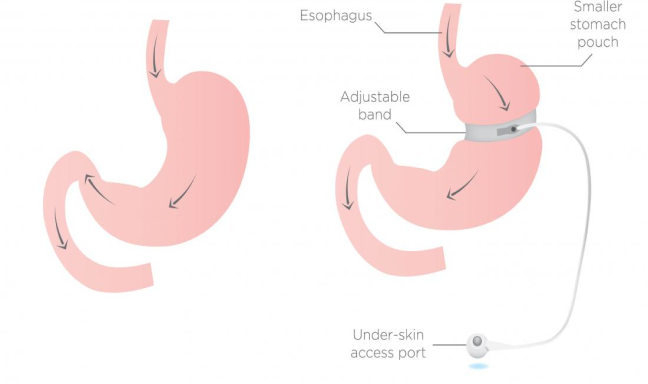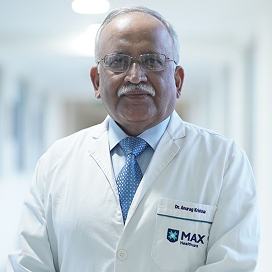Gastric Banding Surgery
Gastric banding surgery, also known as laparoscopic adjustable gastric banding (LAGB), is a popular weight loss procedure designed to help patients with obesity lose excess weight. The procedure involves placing an inflatable band around the upper part of the stomach, creating a small pouch. This restricts food intake by making the patient feel full after consuming smaller amounts of food. Gastric banding is less invasive compared to other bariatric surgeries and can be adjusted or reversed if necessary.

Types of Gastric Banding Surgery
-
Description: This is the most common form of gastric banding surgery. A small adjustable band is placed around the upper part of the stomach to reduce its size and limit the amount of food it can hold. The band can be tightened or loosened over time to adjust the rate of weight loss.
-
Benefits: Minimal invasion, adjustable, reversible, and lower risk compared to other bariatric procedures.
-
Description: Though technically not a gastric banding procedure, this involves placing a soft, expandable balloon in the stomach. The balloon takes up space, helping the patient feel full faster and consume less food. It can be used as a short-term solution or a bridge before other weight loss surgeries.
-
Benefits: Non-surgical option with fewer risks, and can be removed if necessary.
1. Laparoscopic Adjustable Gastric Banding (LAGB)
2. Intragastric Balloon
Who Needs Gastric Banding Surgery?
Gastric banding surgery is typically recommended for individuals who are severely overweight and have struggled with other weight loss methods. Candidates generally meet the following criteria:
-
BMI (Body Mass Index) of 30 or higher , or a BMI of 35 or more with obesity-related health conditions such as type 2 diabetes, hypertension, or sleep apnea.
-
Failure to lose weight through diet and exercise.
-
Inability to lose weight through diet and exercise.
-
No underlying medical or psychological conditions that could interfere with the surgery or recovery process.
-
Willingness to adopt long-term lifestyle changes, including dietary modifications and exercise.
Investigations Required
-
Physical Examination: To assess the patient's overall health and identify any potential risks.
-
Blood Tests: To check for underlying conditions such as anemia, liver function, and kidney health.
-
Endoscopy: To evaluate the stomach and esophagus for any pre-existing issues that could affect the surgery.
-
Chest X-ray: To rule out any lung or heart-related conditions that might complicate surgery.
-
EKG/ECG: A heart examination to ensure it is safe to undergo anesthesia and surgery.
-
Psychological Evaluation: To assess the patient's emotional health and readiness for long-term lifestyle changes.
-
Nutritional Assessment: o ensure the patient is able to follow post-operative dietary restrictions and plan.
Procedure: How Gastric Banding Surgery is Done
-
The patient undergoes a full pre-operative evaluation. General anesthesia is administered to ensure the patient is unconscious during the procedure.
-
Laparoscopic Approach: The procedure is typically done laparoscopically, meaning that only small incisions are made in the abdomen. A tiny, adjustable band is placed around the upper portion of the stomach, creating a small pouch that restricts food intake.
-
Adjustable Band: The band can be inflated or deflated by a healthcare provider through a small port placed under the skin, adjusting the amount of restriction according to the patient's needs.
-
The small incisions are closed, and the patient is taken to the recovery room. The surgery usually lasts around 1-2 hours and requires minimal recovery time.
1. Preparation
2. Surgical Technique
3. Closing Incisions
Length of Stay in Hospital
The length of hospital stay after gastric banding surgery is generally shorter than other bariatric surgeries:
-
Initial Hospital Stay: Typically 1 to 2 days post-surgery. During this time, the patient will be monitored for any immediate complications, and early recovery measures will be taken.
-
Recovery Period: Patients are encouraged to walk and start consuming liquids within 24 hours. Solid foods are usually introduced after a few weeks, once the stomach heals sufficiently.
-
Discharge Criteria: Discharge occurs once the patient can consume liquids comfortably and is free from complications.
Post-Operative Care
Post-operative care is essential for the success of gastric banding surgery. It involves several steps to ensure proper healing and long-term success:
-
Dietary Changes: The patient will be placed on a liquid diet initially, progressing to soft foods, and then solid foods. It is crucial to follow dietary guidelines to avoid stretching the stomach pouch.
-
Adjustments: The gastric band can be adjusted periodically by inflating or deflating the band to ensure optimal restriction and weight loss.
-
Vitamin and Mineral Supplements: To prevent nutritional deficiencies, patients are typically advised to take vitamin and mineral supplements, especially for calcium and iron.
-
Exercise: Regular physical activity should be resumed after the first few weeks, though strenuous exercises should be avoided during the early recovery period.
-
Follow-Up Visits: Regular follow-up appointments are necessary to monitor weight loss, assess any discomfort, and make adjustments to the gastric band.
Risks of Gastric Banding Surgery
Although gastric banding surgery is less invasive than other weight loss surgeries, it carries some risks, including:
-
Band Slippage: The band may slip out of position, requiring surgery to reposition it.
-
Gastric Pouch Enlargement: If the band is too loose or if the patient does not follow dietary instructions, the stomach pouch may enlarge over time, leading to reduced effectiveness.
-
Infection: Infection can occur at the incision sites or around the band.
-
Nutritional Deficiencies: Due to restricted food intake, there may be a risk of vitamin and mineral deficiencies.
-
Band Erosion: In rare cases, the band can erode into the stomach, requiring its removal.
Cost of Gastric Banding Surgery
The cost of gastric banding surgery varies depending on the location, hospital, and complexity of the procedure. Here is an estimated cost breakdown:
| Treatment | Cost Start From($) | Hospital Stay |
|---|---|---|
| Gastric Banding (LAGB) | 5,500 onwards | 1 - 2 Days |
| Intragastric Balloon | 3,500 onwards | 1 - 2 Days |
Success Rate of Gastric Banding Surgery
Gastric banding surgery has a high success rate, particularly for patients committed to making long-term lifestyle changes. Success rates can vary based on the individual, but generally:
-
General Success Rate: About 50-60% of excess weight is lost within the first 1-2 years after surgery.
-
Long-Term Success: With adherence to dietary and lifestyle changes, patients can maintain weight loss over the long term.
-
Improvement in Health Conditions: Many patients experience improvements in obesity-related health conditions, including type 2 diabetes, high blood pressure, and sleep apnea.
At Universelle Medicaid, we work with expert bariatric surgeons and renowned hospitals to offer safe, effective, and affordable gastric banding surgery. If you're considering this procedure, let us help you navigate the process and take the first step toward a healthier, more active life.
TREATMENTS
Obesity Or Bariatric Treatment

Gastric Bypass Surgery
Bladder cancer occurs when abnormal cells grow uncontrollably...
More Information
Gastric Banding Surgery
Gastric banding surgery, also known as laparoscopic adjustable gastric banding (LAGB), is a popular weight loss procedure
More Information
Gastric Sleeve Surgery
Gastric sleeve surgery, also known as sleeve gastrectomy, is a popular weight loss surgery in
More Information
Gastric Bypass Surgery
Bladder cancer occurs when abnormal cells grow uncontrollably...
More Information
Gastric Banding Surgery
Gastric banding surgery, also known as laparoscopic adjustable gastric banding (LAGB), is a popular weight loss procedure
More Information
Gastric Sleeve Surgery
Gastric sleeve surgery, also known as sleeve gastrectomy, is a popular weight loss surgery in
More InformationDoctors
Our Specialist Doctors

Dr. Shashank Chaudhary
Surgical Oncology, Cancer Care



Dr. Vijayant Devenraj
Cardiac Surgery (CTVS), Thoracic



Dr. PrasoonKant Shamshery
Orthopaedics & Joint Replacement



Dr. Vikas Singla
Senior Director & Head – Gastroenterology (Pancreatic-Biliary, Luminal Gastroenterology & Endoscopy Division)



Dr. Anita Sethi
Principal Director & HOD - Ophthalmology (Max Panchsheel & Max Saket)



Dr. Anurag Krishna
Chairman - Paediatrics & Paediatric Surgery Paediatric (Ped) Surgery, Paediatric (Ped) Urology



Dr. Bipin Walia
Vice Chairman & Head- Neurosurgery for Max Saket Complex & Vice Chairman- Neurospine, Max Saket



Dr. Dinesh Khullar
Chairman - Nephrology & Renal Transplant Medicine, Max Saket Complex



Dr. H.N. Bajaj
Principal Director (Orthopaedics) & Head (Spine Surgery) Orthopaedics & Joint Replacement, Spine Surgery, Arthroscopy & Sports Injury



Dr. Harit Chaturvedi
Chairman - Max Institute of Cancer Care Cancer Care / Oncology, Thoracic Oncology, Surgical Oncology, Robotic Surgery, Head & Neck Oncology, Breast Cancer



Dr. Kulbhushan Singh Dagar
Principal Director, Chief Surgeon & Head - Neonatal & Congenital Heart Surgery Paediatric (Ped) Cardiac Surgery, Cardiac Sciences, Paediatrics (Ped)



Dr. Pradeep Chowbey
Chairman - Max Institute of Laparoscopic, Endoscopic, Bariatric Surgery & Allied Surgical Specialities



Dr. Sunil Choudhary
Principal Director & Chief of Plastic Surgery (Max Institute of Reconstructive, Aesthetic, Cleft & Craniofacial Surgery (Miracles) Aesthetic And Reconstructive Surgery



Dr. Abhishek Mishra
MBBS, MS - Orthopaedics Orthopedic surgeon, Joint Replacement Surgeon



Dr. Vineet Malhotra
MBBS | MS – General Surgery | DNB – Urology/Genito – Urinary Surgery



Dr. (Lt Col) Ashok Kumar
Senior Consultant & Head - Radiation Oncology



Dr. Aman Jyoti
Senior Consultant – Paediatrics Cardiac Anaesthesia & Cardiac Intensive Care



Dr. Amit Kumar
Associate Director & Head (Unit I) - Interventional Cardiology



Dr. Anushtup De
Senior Consultant & Head (Unit l) - General & Minimally Invasive Surgery



Dr. Arjun Goel
Senior Consultant & Head (Unit II)- General & Minimally Invasive Surgery



Dr. Dinesh Pendharkar
HOD & Director - Medical Oncology, Cancer Care, Haematology & BMT



Dr. Subhash Hakoo
HOD & Director - General & Minimally Invasive Surgery



Dr. Sujoy Bhattacharjee
HOD & Director - Robotic Joint Replacement



Dr. Tanmay Pandya
HOD & Director - Nephrology & Renal Transplantation



Dr. Ved Prakash
Senior Consultant & Head - Cardiothoracic & Vascular Surgery



Dr. Anuj Agrawal
Sr. Consultant Department of Orthopaedics & Joint Replacement



Dr. Ashwini Kumar Singh
Senior Consultant & Head Plastic, Reconstructive & Cosmetic Surgery



Dr. Nikhil Gupta
Orthopaedics, Arthroscopy & Joint Replacement Surgery



Dr. Sparshi Jain
Consultant in Department of Ophthalmology



Dr. (Maj) Ravi Shankar
Consultant - Haemato-Oncology & BMT MBBS, MD (Pediatrics) Fellowship PHO & BMT



Dr. Amrita Tiwary Vyas
Consultant, Neurosciences/Neurosurgery, Brain & Spine Specialist



Dr. Ankit Agrawal
Consultant, Neurosciences/Neurosurgery, Brain & Spine Specialist



Dr. Sudhir Sharma
Director - Minimal Access, Robotic, Bariatric and General Surgery, MBBS, MS, MBA, FIAGES, FICLS



Dr. Sujoy Bhattacharjee
HOD & Director - Robotic Joint Replacement


Book Appointment
Complete the form below to schedule your appointment.
Begin Your Health Treatment Journey with Us
By utilizing our services, you'll find it easier to improve your well-being and feel better."
Consult Now














